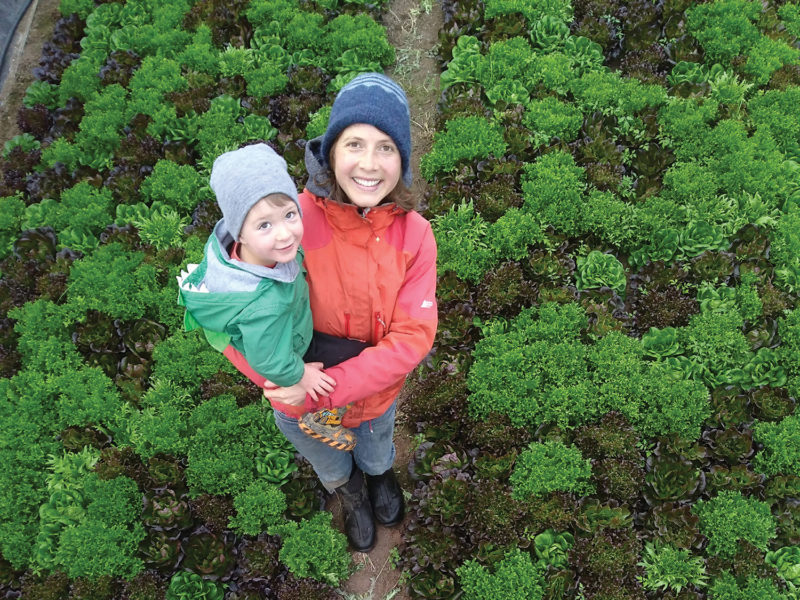SALMO – It’s -8°C and snowing in the central Kootenay town of Salmo, but inside the greenhouse at Salix and Sedge Farm, lettuce and arugula are growing in the soil.
“It’s not really growing, it’s more like being in a refrigerator,” clarifies Brendan Parsons who with his partner Cali Olleck owns the farm. “The low winter light and the temperature just above zero keep the plants alive, but mostly dormant, and we are able to harvest fresh lettuce through the winter.”
Parsons and Olleck are just finishing up their first complete year of running the greenhouse, built as an addition to their five-year old market garden. Rather than cram all their production into six months like other market gardeners, a greenhouse was a way to broaden their production window.
“We were looking to balance our workload over the course of the year and extend our season,” says Parsons. “We began by growing storage crops that we could sell during the winter and create some additional cash flow, and the greenhouse is a way to extend that and give us some work during the winter.”
The greenhouse also allows them to produce high-value crops out of season, a key element of their business plan.
Those greens were sown in September, and although the greenhouse gives the couple the technology to hold them through February, they were sold out by Christmas. Come March, they will be seeding tomatoes and cucumbers with an intercropping of greens.
“We will start harvesting the cucumbers in early May and the tomatoes will be ready in June,” says Parsons.
That’s early by any standard. By comparison, the cherry tomatoes they grew outside last year under high tunnels weren’t ready until August.
Parsons says the greenhouse revenue has allowed them to ease out of their off-farm jobs (Parsons worked as a carpenter, and Olleck was in forestry) and have a bit more time for their three-year old son as well as the skiing and climbing that drew them to the area in the first place.
“I was living in Nelson and Cali was going to school in Castlegar and we were looking to farm, but still stay attached to the outdoor community here,” he says.
The two are new farmers. Olleck completed a year at Kwantlen Polytechnic University’s farm school in Richmond and Parsons did a gardening program at Linnaea Farm on Cortes Island prior to starting Salix and Sedge.
“But it would have been good to have spent time on a commercial farm to learn the business side of things,” says Parsons.
The farm initially had chickens, pigs and bees, but they have focused on vegetables over the last three years.
Their 20-acre property is tucked away on the west side of the Salmo River just outside of town. The name reflects the surrounding ecosystem. Salix is a genus of willow in the area and sedge is the primary perennial weed the farm has to deal with.
“Our soil is wonderful Salmo River bottom, but we have a lot of wetlands on our property,” explains Parsons. “We have been able to lease a neighbouring property that has the same great soil, but better drainage where we have our garden and greenhouse.”
The property sits on a natural gas mainline.
“The gas line was an important part of our decision to build the greenhouse, but I think that using propane would be a similar cost,” says Brendan.
The 120×35-foot greenhouse was manufactured in Quebec and engineered to withstand the snow load in Salmo. Two layers of polyethylene with air in between provide cover and some insulation.
“It sheds the snow really well, but I have to clear the snow from around the base with a blower attachment for my tractor,” explains Parsons. “We get so much [snow] here that it would impact the wall of the house if I didn’t clear it.”
Salmo itself is a small community, but it’s in a strategic location, being a half-hour drive from the three main towns in the central Kootenays. Their certified organic produce is available at grocers in Castlegar, Nelson and Trail, and at their farm stand.
“We don’t have a retail outlet in Salmo, but we are so close to town that people can ride their bikes or even walk to our farm store and we have enough of a range of vegetables to make it worth their trip,” says Parsons. “The local community has been really supportive of our farm, and more so this year. We have been able to sell out everything that we have grown.”
The greenhouse has been a steep learning curve.
“It’s only been our first year and I imagine that in five years we will look back and realize we have come a long way,” says Parsons.
Plant nutrition, pest and disease management as well as responding to shifting temperatures have all been new challenges. An outbreak of spider mites shortened their cucumber season.
“We need to develop a better IPM plan this year,” says Parsons, noting the lack of other greenhouses in the area to share ideas.
But that could change. Kootenay & Boundary Farm Advisors organized an early November tour of Salix and Sedge for 12 attendees who had a “commercial interest” in greenhouse production.
“They had some very in-depth discussion of the greenhouse business,” says KBFA coordinator Rachael Roussin.


 Pacific Agriculture Show kicks off
Pacific Agriculture Show kicks off